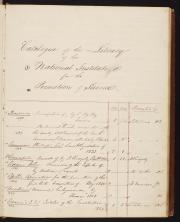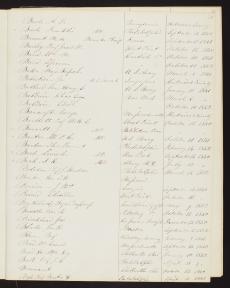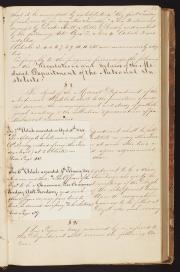 Before the Smithsonian existed, there were two other institutions created for the promotion of science and diffusion of knowledge. The first one was the Columbian Institute, which was established in 1816 by Edward Cutbush. The Institute’s only solid contribution was a small botanical garden on the National Mall, and when their charter expired in 1838, it was not renewed. The books and specimens collected by the Columbian Institute were absorbed by the National Institute, the second institution to pre-date the Smithsonian, upon its creation in 1840.
Before the Smithsonian existed, there were two other institutions created for the promotion of science and diffusion of knowledge. The first one was the Columbian Institute, which was established in 1816 by Edward Cutbush. The Institute’s only solid contribution was a small botanical garden on the National Mall, and when their charter expired in 1838, it was not renewed. The books and specimens collected by the Columbian Institute were absorbed by the National Institute, the second institution to pre-date the Smithsonian, upon its creation in 1840.
The National Institute, originally named the National Institute for the Promotion of Science, was founded on much the same principals as the Columbian Institute, but its creation is believed to have been spurred by a mission to gain control of Smithson’s bequest. It was organized in a similar fashion to the Columbian Institute, with resident and corresponding members, and several of the original members of the National Institute had previously been members of the Columbian Institute. However, the National Institute tried to avoid the fate of its predecessor by reaching out to new individuals through specialized initiatives.

 One of these such initiatives was the Medical Department of the National Institute, which was formed on November 10, 1842. The medical department was founded specifically for “the promotion of medical science, the encouragement and study of pathological anatomy and the collection and preservation of pathological specimens.” The department met multiple times a year to discuss various papers and topics that had been presented by members of the field. During the meeting of November 4, 1844, a lively discussion was had about the uses and abuses of medicine, with particular focus on quinine, which is used to treat malaria. The department was only able to meet two more times after that before waning interest in the group resulted in its dissolution.
One of these such initiatives was the Medical Department of the National Institute, which was formed on November 10, 1842. The medical department was founded specifically for “the promotion of medical science, the encouragement and study of pathological anatomy and the collection and preservation of pathological specimens.” The department met multiple times a year to discuss various papers and topics that had been presented by members of the field. During the meeting of November 4, 1844, a lively discussion was had about the uses and abuses of medicine, with particular focus on quinine, which is used to treat malaria. The department was only able to meet two more times after that before waning interest in the group resulted in its dissolution.
The National Institute also tried to build a library and collection of objects and specimens to secure its existance. The materials acquired by the Columbian Institute before it dissolved helped provide a foundation for such a collection, as did the contribution of materials written by members of the National Institute. However, the biggest boost to the collection came from the United States Exploring Expedition of 1838 to 1842. During the expedition, specimens of all varieties were collected and sent back to the United States for distribution across the country, with many joining the collections of the National Institute. Due to the influx of materials from the expedition, plans were made to build a national gallery to house the collection and library.

Unfortunately for the National Institute, Smithson’s bequest was used to form the Smithsonian Institution in 1846. After that, it was difficult to gain government support for exhibit space and the institute began to fade. On July 28, 1862, the charter of the National Institute officially expired and its library and collections were given to the Smithsonian.
Related Resources
- Record Unit 7058, National Institute, Records, 1839-1863 and undated, Smithsonian Institution Archives
- Record Unit 7051, Columbian Institute, Records, 1816-1841, with related papers, 1791-1800, Smithsonian Institution Archives
- Benjamin the Anti-Christ's Doomsday Prophecy, The Bigger Picture, Smithsonian Institution Archives
Produced by the Smithsonian Institution Archives. For copyright questions, please see the Terms of Use.

Leave a Comment